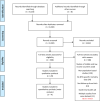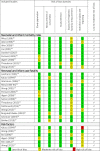Neonatal and infant mortality associated with spina bifida: A systematic review and meta-analysis
- PMID: 33979363
- PMCID: PMC8115829
- DOI: 10.1371/journal.pone.0250098
Neonatal and infant mortality associated with spina bifida: A systematic review and meta-analysis
Abstract
Objectives: A systematic review was conducted in high-income country settings to analyse: (i) spina bifida neonatal and IMRs over time, and (ii) clinical and socio-demographic factors associated with mortality in the first year after birth in infants affected by spina bifida.
Data sources: PubMed, Embase, Ovid, Web of Science, CINAHL, Scopus and the Cochrane Library were searched from 1st January, 1990 to 31st August, 2020 to review evidence.
Study selection: Population-based studies that provided data for spina bifida infant mortality and case fatality according to clinical and socio-demographical characteristics were included. Studies were excluded if they were conducted solely in tertiary centres. Spina bifida occulta or syndromal spina bifida were excluded where possible.
Data extraction and synthesis: Independent reviewers extracted data and assessed their quality using MOOSE guideline. Pooled mortality estimates were calculated using random-effects (+/- fixed effects) models meta-analyses. Heterogeneity between studies was assessed using the Cochrane Q test and I2 statistics. Meta-regression was performed to examine the impact of year of birth cohort on spina bifida infant mortality.
Results: Twenty studies met the full inclusion criteria with a total study population of over 30 million liveborn infants and approximately 12,000 spina bifida-affected infants. Significant declines in spina bifida associated infant and neonatal mortality rates (e.g. 4.76% decrease in IMR per 100, 000 live births per year) and case fatality (e.g. 2.70% decrease in infant case fatality per year) were consistently observed over time. Preterm birth (RR 4.45; 2.30-8.60) and low birthweight (RR 4.77; 2.67-8.55) are the strongest risk factors associated with increased spina bifida infant case fatality.
Significance: Significant declines in spina bifida associated infant/neonatal mortality and case fatality were consistently observed, advances in treatment and mandatory folic acid food fortification both likely play an important role. Particular attention is warranted from clinicians caring for preterm and low birthweight babies affected by spina bifida.
Conflict of interest statement
The authors have declared that no competing interests exist.
Figures












References
-
- Kurinczuk J.J., Hollowell J., Boyd P.A., Oakley L., Brocklehurst P. and Gray R., 2010. Inequalities in infant mortality project briefing paper 4. The contribution of congenital anomalies to infant mortality. Oxford: National Perinatal Epidemiology Unit, 2010.
-
- MRC Vitamin Study Research Group. Prevention of neural tube defects: results of the Medical Research Council Vitamin Study. The lancet. 1991. July 20;338(8760):131–7. - PubMed
Publication types
MeSH terms
Grants and funding
LinkOut - more resources
Full Text Sources
Other Literature Sources
Medical
Miscellaneous

